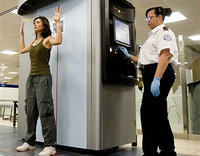-
New scanner allows passengers to take liquids on board

A new bottle scanner enables aircraft passengers to carry liquid items larger than 100 ml once more; airports could now allow passengers to take items such as water, cosmetics, perfumes, and duty free through airport security channels from as early as 2013
-
-
Canada tests explosive detecting ticket readers
In a pilot program, Canadian light rail passengers in Edmonton will be scanned for explosives as they pass through ticket turnstiles in a seamless system that avoids recreating the long lines of airport security checkpoints
-
-
Death of fourteen bomb dogs sparks $1 million lawsuit

A firm that trains bomb sniffing dogs for law enforcement and military personnel is suing a transportation company for more than $1 million over the deaths of fourteen highly-trained canines bound for Afghanistan
-
-
Implant Sciences sells $200,000 in explosives detectors to Mexican government
Last week Implant Sciences announced that it had received an order for more than $200,000 worth of its portable explosives detectors from the Mexican government
-
-
Safer fertilizer technology

Honeywell will build a facility in California to produce a fertilizer with the agronomic benefits of traditional nitrate-based fertilizers, but with significantly lower explosive potential; the new fertilizer was independently tested, with guidance from the DHS and the Bureau of Alcohol, Tobacco, Firearms and Explosives, and demonstrated significantly less or no explosive power
-
-
Inmates help train bomb-sniffing dogs
In an interesting turn of events, prison inmates are being used in a pilot program designed to train future law enforcement officers; inmates at the Panama City- Bay County jail will help train two future bomb-sniffing dogs
-
-
Wearing shoes at airport checkpoints could be a new reality

As part of its continuing efforts to make security procedures at airport checkpoints easier for travelers, the Transportation Security Administration (TSA) is actively seeking technological solutions that would allow passengers to keep their shoes on
-
-
Graphene foam detects explosives better than gas sensors
Researchers demonstrate that graphene foam can outperform leading commercial gas sensors in detecting potentially dangerous and explosive chemicals; the discovery opens the door for a new generation of gas sensors to be used by bomb squads, law enforcement officials, defense organizations, and in various industrial settings
-
-
TSA chief says no new study needed on airport body scanners

Weeks after agreeing in principal to an independent study on the health effects of full-body scanners, TSA administrator John Pistole told the Senate Committee on Commerce, Science, and Transportation that a new study is not needed to confirm the machines’ safety
-
-
Examining shoes for trace amounts of explosives – discreetly

NIST has been developing a prototype shoe sampling system that relies on aerodynamic sampling as the primary mechanism for liberating, transporting, and collecting explosive contamination
-
-
Europe bans the use of backscatter body scanners
In its approval of full body scanners for use at airports last week, the European Union banned the use of scanners that relied on backscatter radiation due to safety concerns; these types of scanners are widely used in the United States and have been source of sharp criticism, yet the Transportation Security Administration (TSA) has continued to insist that they are safe
-
-
DNDO progressing on Helium-3 alternative
DHS is one step closer in its quest to find an alternative to Helium-3, a key element used in radiation scanners that detect illegal nuclear or radiological materials; DHS’s Domestic Nuclear Detection Office (DNDO) recently announced that it had completed its final analysis on Helium-3 alternatives
-
-
EU to allow full-body scanners at airports

In response to the continued threat of terrorism, the European Union (EU) recently passed legislation that would formally European airports to use full-body scanners; prior to Monday’s announcement, trial usage of full-scanners was limited to a period of thirty months; under the new rules, member states will have the option for unlimited deployment of the scanners, but will not be required to use them
-
-
Researchers develop printable explosive detectors
Researchers at the Georgia Institute of Technology are developing a low-cost explosives detector that can be printed on an inkjet printer; the explosive detector uses a wireless sensor to detect trace amounts of ammonia, a key chemical used in improvised explosive devices (IEDs), the deadliest killer of U.S. troops in Iraq and Afghanistan
-
-
New detector can identify homemade explosives in under a minute
A new technique could help investigators identify the type of explosive used in an attack in less than sixty seconds; the new technology is designed to aid security personnel in detecting homemade explosives, which are more difficult to detect
-
- All
- Regional
- Water
- Biometrics
- Borders/Immig
- Business
- Cybersecurity
- Detection
- Disasters
- Government
- Infrastructure
- International
- Public health
- Public Safety
- Communication interoperabillity
- Emergency services
- Emergency medical services
- Fire
- First response
- IEDs
- Law Enforcement
- Law Enforcement Technology
- Military technology
- Nonlethal weapons
- Nuclear weapons
- Personal protection equipment
- Police
- Notification /alert systems
- Situational awareness
- Weapons systems
- Sci-Tech
- Sector Reports
- Surveillance
- Transportation
Advertising & Marketing: advertise@newswirepubs.com
Editorial: editor@newswirepubs.com
General: info@newswirepubs.com
2010-2011 © News Wire Publications, LLC News Wire Publications, LLC
220 Old Country Road | Suite 200 | Mineola | New York | 11501
Permissions and Policies
Editorial: editor@newswirepubs.com
General: info@newswirepubs.com
2010-2011 © News Wire Publications, LLC News Wire Publications, LLC
220 Old Country Road | Suite 200 | Mineola | New York | 11501
Permissions and Policies
